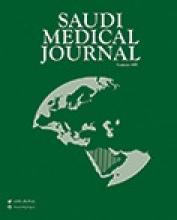Abstract
OBJECTIVE: To review clinical presentations, diagnosis, response to treatment, and outcome of infants with neonatal hemochromatosis (NH).
METHODS: This is a retrospective review of all cases admitted to the Pediatric Department at Salmaniya Medical Center, Manama, Bahrain between March 2008 and May 2011. The diagnosis was based on serum iron and ferritin, alpha-fetoprotein levels (AFP), liver and buccal biopsies, and abdominal MRI scan.
RESULTS: Ten patients (8 males and 2 females) were diagnosed with NH. Two patients were intrauterine growth restriction (IUGR) and 6 were preterm. The median birth weight was 1.700 grams. The median age at presentation was 16 days, and at diagnosis was 23 days. Two patients had positive consanguinity. Clinical presentations of the infants were hepatosplenomegaly (n=5), ascites (n=3), and hypoglycemia (n=6). All patients had raised ferritin levels, prolonged prothrombin time, and 9 patients had high serum iron and serum AFP. Abdominal MRI showed iron overload in the liver (n=8). Liver biopsies showed evidence of hemochromatosis (n=3). Buccal biopsies stained positive for iron (n=1). Eight patients received antioxidant therapy and survived. Two patients passed away.
CONCLUSION: Neonatal hemochromatosis is a rare liver disease of newborns with a spectrum of clinical severity. Elevated serum ferritin and AFP support the diagnosis after excluding other causes of neonatal liver failure. The use of antioxidant therapy helps to improve the outcome.
- Copyright: © Saudi Medical Journal
This is an open-access article distributed under the terms of the Creative Commons Attribution-Noncommercial License (CC BY-NC), which permits unrestricted use, distribution, and reproduction in any medium, provided the original work is properly cited.






